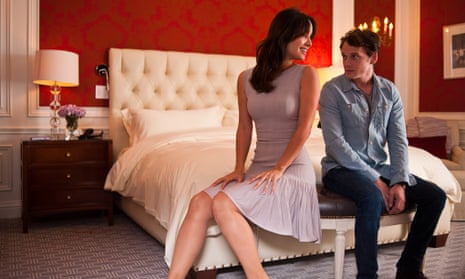There is a certain type of romantic that is drawn to doomed love stories. If you’d take Doctor Zhivago over Sleepless in Seattle, you may want to book some time for 5 to 7.
Set in a New York where cellphones barely exist, a gentleman wouldn’t be caught dead without a tie at dinner and a would-be author still tacks his rejection letters to the wall (I guess he prints them out first?), 5 to 7 is a full carafe of cliche but nonetheless intoxicating. Young Brian Bloom (Anton Yelchin), winner of the Tobey Maguire lookalike contest, taps out short stories in a Manhattan studio while his parents urge him to go to law school. On one of his many walks around the Upper East Side in his tan sports coat, he spots Arielle (Bérénice Marlohe) fumant une cigarette outside the St Regis Hotel. He speaks to her, in French, and the flirtation goes well. Though she’s 33 (he’s 24) she suggests they meet again, as she is free “from 5 to 7”.
Yelchin’s nice Jewish boy from upstate doesn’t recognize this is code for “let’s begin a tasteful extramarital affair”, but when, after a photogenic trip to the Guggenheim, Areille explains that she is the wife of a French diplomat who has a mistress all his own, he hits the eject button. But good luck getting back to your spec short stories when it’s spring and a French ex-model has invited you to a hotel.
Thus begins the affair, and with Yelchin’s character reflecting from afar via a voiceover, there’s only a soupçon of tawdriness in an otherwise sweet engagement. There’s conversation, cultural exchange (oenophilia versus beer swilling) and yet another cinematic example of Central Park being the most romantic place on Earth. Arielle tells Brian he is “a natural lover whose body expresses beautifully what’s in your heart”. It’s the type of thing only someone with an accent can get away with, and Marlohe nails it.
When Yelchin responds, “wait, let me write this down”, it’s one of the few times he may as well be doing a full-on Woody Allen impression, in a film that emulates the great New York auteur without totally aping him. (Well, director Victor Levin does get his one lick in – he appropriates the Annie Hall “Wagner, Max, Wagner!” shot of two walker-talkers emerging from sidewalk obscurity to the foreground, but when you are so clearly a fan and the opportunity presents itself … the heart wants what it wants, no?)
As the romance continues, there are a handful of charming set pieces. In an inspired bit of casting, Glenn Close and Frank Langella play Mr and Mrs Bloom, proving that you don’t need to be Jewish to be a Jewish parent. Langella is particularly amusing, eschewing the typical “oy”s but still fretting about parking. He gets some solid zings in, like referring to Arielle as “La Femme Robinson”. Another sequence brings Brian to a dinner party at Arielle’s home, where he meets her children, her husband (Lambert Wilson) and her husband’s mistress (Olivia Thirlby) and where everyone (including the guests – is that Julian Bond? It is!) knows what everyone else is doing there.
Perhaps a French person should vet this film, but the gag seems to be that it is right to marry and have a family with someone you admire, but it also essential to keep a twentysomething on the side to stay alive. And when you, the twentysomething, grow and have a family of your own, you should continue the cycle. I’m not going to give my opinion on this theory (my wife may be reading), but I’ll say that 5 to 7 makes a compelling case. This means, of course, that heartbreak is in order somewhere along the way, especially when a provincial American makes his way into the mix. 5 to 7’s last act goes all-in on schmaltz with a big orchestral score and lots of long-held glances.
A leitmotif of 5 to 7 includes cutting to the plaque dedications that adorn the benches in Central Park. If you’ve ever ambled along and read them (in a tan sports coat, hopefully) you’ve experienced that special blend of sweet and sad sentimentality. If you don’t have the energy to read each one, you can carve out a little time with 5 to 7.

Comments (…)
Sign in or create your Guardian account to join the discussion